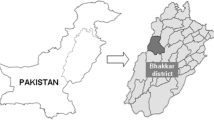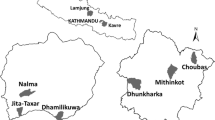Abstract
In the Padma floodplain of Bangladesh, the traditional system of agriculture has become unsustainable due to high population growth. Mango-based agroforestry which has been practiced by the farmers since the 1990s, is a promising alternative and is considered as one of the few options to lift farmers out of poverty and improve livelihood security. This paper examines the potential of mango-based agroforestry to improve livelihoods, using data collected by rapid rural appraisal, farmer participatory research, stakeholder analysis and a farm household survey in six representative villages in the floodplain. Farmers with the least land were found to allocate a higher percentage of their land to agroforestry, and the increased income from agroforestry compared to other agricultural systems helps reduce relative poverty. This income maintains basic household needs, providing food security and fuelwood, and contributes to healthcare, housing and sanitation conditions, and meeting educational expenses.

Similar content being viewed by others
Notes
The taungya system involves the planting of cash or food crops between newly planted forest seedlings in a reforestation or plantation project (Alam et al. 1996).
1 ac = 0.41 ha.
The Government and NGOs provide farmers with essential information, training and subsidised seeds and seedlings.
An upazila is a sub-district.
RRA was conducted with the people of study site to understand basic information of the villages (e.g. location of farm households, distance of cultivation fields, crop calendar).
In this study ‘poor’ has been defined by considering farmers’ incomes. ‘Poor’ are taken as those with incomes of not more than US$1.25 per person per day, following UNDP (2010 ).
USD 1 = BDT (Bangladesh Taka) 68.40 as of November 2009.
Land-grabbing is prevented because planting trees improve resource tenure by greater monitoring and control over land.
References
Abedin MZ, Lai CK, Ali MO (eds) (1990) Homestead plantation and agroforestry in Bangladesh. Bangladesh Agricultural Research Council and Winrock International, Dhaka
Alam MK, Mohiuddin M, Basak SR (1996) Village trees of Bangladesh: diversity and economic aspects. Bangladesh J For Sci 25(2):21–36
Alim A (1993) Agroforestry practices in Bangladesh. In: Mahat TBS (ed) Agroforestry training course module in Bangladesh. Bangladesh Agricultural Research Council, Dhaka, pp 21–29
MacDicken KG, Vergara NT (1990) Agroforestry: classification and management. Wiley, New York
Mai PT (1999) Socio-economic analysis of shifting cultivation versus agroforestry system in the upper stream of lower mekong watershed in Dak Lak province. M.A thesis in Economics of Development. College of Economics, National University-HCMC, Viet Nam and Institute of Social Study (ISS), Rotterdam
Rahman SA, Rahman MF, Codilan AL, Farhana KM (2007) Analysis of the economic benefits from systematic improvements to shifting cultivation and its evolution towards stable continuous agroforestry in the upland of eastern Bangladesh. Int For Rev 9(1):536–547
Rahman SA, Groot WD, Snelder DJ (2008) Exploring the agroforestry adoption gap: financial and socioeconomics of litchi-based agroforestry by smallholders in Rajshahi (Bangladesh). In: Snelder DJ, Lasco RD (eds) Smallholder tree growing for rural development and environmental services: lessons from Asia. Springer, The Netherlands, pp 227–244
Rasul G, Thapa GB, Zoebisch MA (2004) Determinants of land-use changes in the Chittagong hill tracts of Bangladesh. Appl Geogr 24(1):217–240
Siddiqui MA, Khan NA (1999) Floristic composition and socio-economic aspects of rural homestead forestry in Chittagong: a case study. Bangladesh J For Sci 28(1):94–101
UNDP (United Nations Development Programme) (2010) Human development report 2010. Palgrave Macmillan, New York
Acknowledgments
We wish to thank the Department of Sociology of the University of Rajshahi, CIFOR and the IC-SAAKTI Project for providing financial support for this research. We are also grateful to Professors Khan, Siddiquee and Hossain for their valuable advice and guidance. Many thanks are also given to the farmers at the field survey sites, who shared their precious time, thoughts and concerns, and even their sometimes scarce meals with us.
Author information
Authors and Affiliations
Corresponding author
Rights and permissions
About this article
Cite this article
Rahman, S.A., Imam, M.H., Snelder, D.J. et al. Agroforestry for Livelihood Security in Agrarian Landscapes of the Padma Floodplain in Bangladesh. Small-scale Forestry 11, 529–538 (2012). https://doi.org/10.1007/s11842-012-9198-y
Accepted:
Published:
Issue Date:
DOI: https://doi.org/10.1007/s11842-012-9198-y




